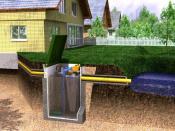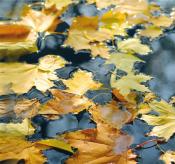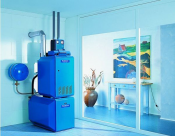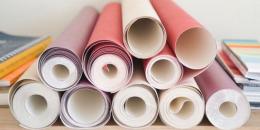Search
Login
Recommended
How to avoid mistakes when choosing and sticking wallpaper
With a huge selection of finishing materials, wallpaper does not leave the stage. In this article we will try to answer the basic questions about the properties and quality of various types of wallpaper.
Content
- Paper wallpaper
- Vinyl wallpaper, do they breathe? video
- What is natural wallpaper? video
- Metallic wallpaper - protection against electromagnetic radiation
- Willingness of the wall for wallpapering video
- How to repair the joints of glued wallpapers?
- How to avoid mistakes
- Calculation of the number of rolls
Paper wallpaper
Paper wallpapers are considered the most environmental.
Such wallpapers are of two types: simplex - thin single-layer, duplex - more durable two-layer.
Paper wallpapers, when wet, change their geometric parameters, this creates a problem, as they stretch, and when dry, they shrink. As a result, wrinkles may appear.
If you want to stick wallpaper in a quality manner, do not stretch the canvas while pasting.
With the choice, purchase a duplex wallpaper. These wallpapers get only one layer wet, which guarantees against errors.
In addition, duplex wallpapers have a different embossing; the service life of high-quality paper wallpapers is quite long.
Paper wallpapers, in comparison with other types of wallpaper, burn out more strongly, they cannot be washed.
Vinyl wallpaper, do they breathe?
High-quality vinyl wallpapers are made on the basis of non-woven textiles - non-woven, it does not shrink.
In addition, vinyl wallpapers have the advantage that there is a huge assortment of drawings, for a designer this is a huge field of activity. But consumers are constantly asking, are they breathing?
We will deal with this issue.
Vinyl is polyvinyl chloride, there is nothing natural in such material, and this scares the buyer. But according to international standards adopted in Europe, in the production of vinyl wallpapers, it is forbidden to use heavy metals and volatile dyes.
A lot of the objects surrounding us are made of vinyl, in the initial state, vinyl is a paste, a special ingredient is added to it, when heated, it forms the porous structure of the material.
We conclude: if the vinyl is porous, air and moisture pass through it. Check this elementary: pour water on the canvas, and after ten minutes, it will appear on the back of the base.
Try to tear a piece of wallpaper, it breaks, and only porous material can break so easily.
What is natural wallpaper?
Natural, plant-based wallpapers are wall coverings.
The decorative layer of such wallpaper consists of bamboo lamellas, fibers or shoots of jute, arrowroot, sisal, rattan, cane, cherry veneer, sandalwood, apricot and other valuable wood species.
For walls, this is one of the cleanest environmental materials. The basis of natural wallpaper, most often, is thick paper, but despite this, natural wallpaper does not shrink, the fact is that natural fibers are a reinforcing binder, i.e. Natural wallpapers can move a little.
The decorative layer gradually fades over time, and if ultraviolet radiation constantly gets on the wallpaper, then in one season they can burn out.
Wallpaper from sisal.
But experts believe that wallpapers like good cognac or expensive wine are getting better over the years.
Time and changes in natural wallpaper only emphasize their naturalness.
Metallic wallpaper - protection against electromagnetic radiation
Among modern wallpapers there are metallized wallpapers combined with cork.
The cork coating itself has gaps in the structure, manufacturers use it as follows: a layer of foil is placed under the layer of the cork, depending on the color of the foil, a silver, gold or copper substrate is visible.
Using this method of metallization, an excellent decorative effect is achieved.
In addition to beauty, for a consumer who is worried about the effect of electromagnetic radiation on the body, metallized wallpapers create a kind of screen - it reduces the electromagnetic radiation that spreads from neighbors through the wall.
Willingness of the wall for wallpapering
In preparation for wallpapering the walls, they should be smooth, dry, durable and plain.
After you remove the old wallpaper, you need to check whether the plaster is streaming.
You can check it in different ways, for example, hold it with a spatula on the wall, if it is strewed, it means that the surface is fragile.
You can stick tape, if you tear it off and stucco remains on it, there is a danger that in some places the plaster may peel off along with the glued wallpaper.
If such flaws are identified, before wallpapering, the walls should be plastered.
To check the readiness of freshly applied plaster - glue the cellophane bag with tape on the wall at night, if condensation has collected on it in the morning - the wall is not dry enough.
The prepared surface should be monophonic, if there are spots on the wall, they can be visible.
How to repair the joints of glued wallpapers?
Sometimes, after some time after the repair, the joints are opened. This may be due to a draft or because the room is too hot or cold.
There is a special glue, it is called glue for joints or glue for borders, in the composition they have the same basis.
Such glue provides better adhesion than ordinary wallpaper.
When the wallpaper leaves, they become hard and warp, experts advise to spray them with water, soak, and use the above glue in order to correct the situation.
But keep in mind that if wallpaper glue is colorless, then the glue for joints is white, so this glue must be used carefully so that it does not get on the front side of the wallpaper, otherwise it will be difficult to remove it.
How to avoid mistakes?
Old paper wallpapers had to be cut off, such wallpapers had to be glued in the direction from the window, so that the joints were not visible. Here is a table with useful information that is useful when buying wallpapers.
Now the canvases are glued butt, so many craftsmen begin to work from the middle of the wall.
First of all, this is due to the design of the wallpaper.
In order for a wallpaper with a large pattern to look beautiful, the pattern should diverge from the center to the sides and end equally in the corners.
The temperature in the room should not be lower than 18 degrees Celsius.
No one can guarantee that the wallpaper will not fall off if you glue it in the winter in an unheated room. But it is impossible to carry out work in the heat, at a temperature above 30 degrees Celsius, under these conditions, the drying time of the wallpaper sharply decreases, the coating can peel off during accelerated drying.
During the sticker of the wallpaper, it is necessary to close the windows and doors, there should be no drafts in the room for 24 hours, the room temperature should be 18-22 degrees Celsius.
It is important to glue the first canvas on the level and be sure to bring it to the corner, the next canvas should be glued clearly from the corner, again on the level.
Calculation of the number of rolls
A competent seller will calculate the required number of rolls if the buyer knows the area of \u200b\u200bglued walls or the perimeter of the room.
To determine the number of rolls, the perimeter of the room without openings is divided by the width of the roll and the number of paintings that is obtained from one roll.
The standard European roll length is 10.05 meters.
With a ceiling height of more than 2.5 meters, only three canvases can be cut from one roll, three canvases will turn out if you choose wallpaper with a picture.
Four canvases will come out of a roll, if the wallpaper does not require the selection of a picture, and the ceiling height does not exceed 2.5 meters.
For wallpapers that are sold per meter, the calculation is different: the perimeter of the room is divided by the width of the roll, and then the result obtained by the number of paintings.





